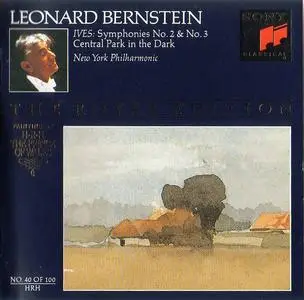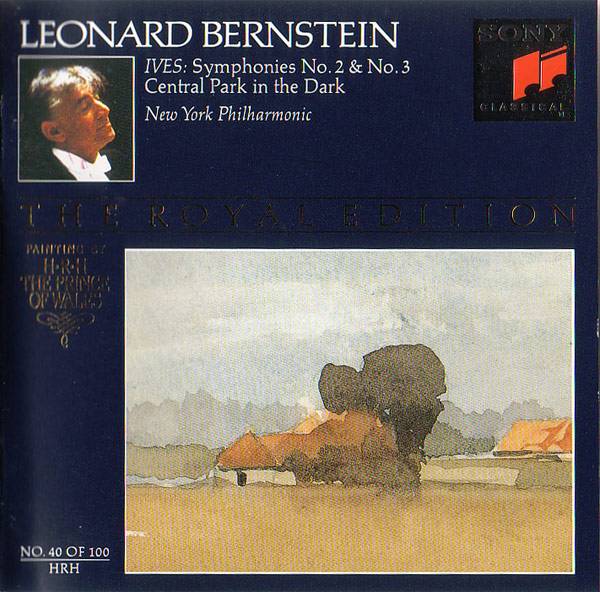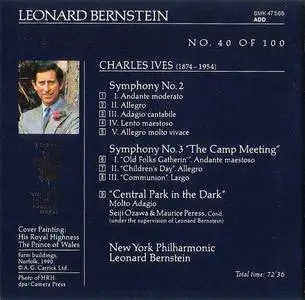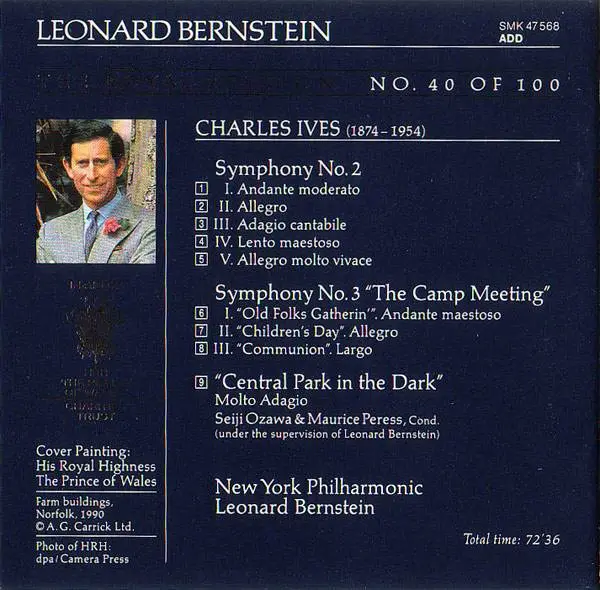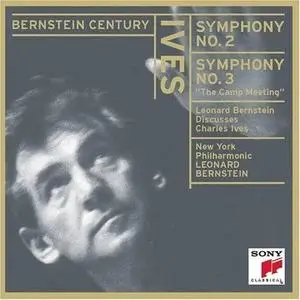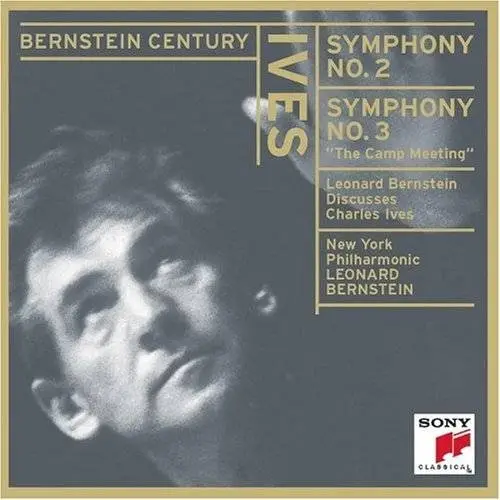Charles Ives - Symphony no.2 and 3 - NewYork Philharmonic Orchestra, Leonard Bernstein _Central Park in the dark, NYP, Seiji Ozawa
Early 20th century | EAC: Apple lossless, no CUE, no LOG | 350 Mb +booklet
1990 Sony Classical HRH 40 | Eng
Early 20th century | EAC: Apple lossless, no CUE, no LOG | 350 Mb +booklet
1990 Sony Classical HRH 40 | Eng
Ives composed the Second Symphony from circa 1900 to 1902. He also made revisions to the work in 1909 and 1910.
Leonard Bernstein and the New York Philharmonic Orchestra premiered the Second Symphony on February 22, 1951 in Carnegie Hall, New York City. The concert was also broadcast nationally. The story of Ives' reaction to the premiere is an interesting one. Ives refused to attend the concert, so his wife Harmony attended the concert at Carnegie Hall without him.
Ives' Third Symphony is Ives' most gentle, meditative music. Like most of his greatest works, the Third is also profoundly spiritual. But the sense of quest, of striving for transcendence that appears in many of his works is nowhere to be found in the Third.
In many regards, the Symphony No. 2 represents the pinnacle of Ives' success as a respectable composer. By "respectable," I mean that in this symphony Ives was working within the confines of a clearly defined formal tradition. More broadly speaking, by "respectable" I also mean that this work sounds more acceptable to folks regularly listen to Romantic composers like Brahms, Dvorak, and Tchaikovsky. In fact, people who usually don't like Three Places in New England–much less the Fourth Symphony–often point to the Second and hold it up as something a bit more palatable–Ives without the cranky eccentricities.
Later in his life, Ives regarded the symphony as one of his "soft" works, because it lacks many of the dissonant and rhapsodic characteristics that appear in his later works. But that attitude sells the work short. Keep in mind that Ives probably began the work while he was still at Yale! So, it is not a work of his full maturity. Sure, Ives doesn't try to scale the transcendent heights and catch a glimpse of the divine like he does so often later, but it's still a fascinating work. Don't forget too: Many of the original features of Ives' later and best works are already in full display by the time he composed the Second.
Ives composed the Second Symphony from circa 1900 to 1902. He also made revisions to the work in 1909 and 1910. Ives claimed that everything in the Second Symphony was derived from earlier compositions, most of which are now lost:
* The first movement (Andante moderato) was based on the Sonata for Organ and "Down East Overture." Both of these are now lost.
* The second movement (Allegro) was based on music from the lost Set of Overtures: In These United States.
* The third movement (Adagio cantabile) originally was part of the Symphony No. 1, though it was removed from that work at his teacher Horatio Parker's insistence.
* The fourth movement [Lento (maestoso)] is based on the lost Overture: Town, Gown, and State.
* The final movement (Allegro molto vivace) originated as the Overture: The American Woods, also now lost.
Even though we'll never hear the lost works in their original form, I find the titles themselves fascinating. They certainly point toward Ives' abiding concerns and preoccupations throughout his life. Formally, the Symphony No. 2 owes much to Tchaikovsky, Dvorak, and especially Brahms' First.
Leonard Bernstein and the New York Philharmonic Orchestra premiered the Second Symphony on February 22, 1951 in Carnegie Hall, New York City. The concert was also broadcast nationally. The story of Ives' reaction to the premiere is an interesting one. Ives refused to attend the concert, so his wife Harmony attended the concert at Carnegie Hall without him. In his biography of Ives, Jan Swafford relates Ives' reaction to the radio broadcast of the concert:
In legend, [Ives] heard it on the maid's radio and did a little dance of joy afterward. In reality he was dragged next door to the Ryders' to hear the broadcast and, unlike similar occasions, sat quietly through the whole thing. It was one of his soft pieces, as he called them; it was also perhaps the warmest audience reception of his whole life. As cheers broke out at the end everybody in the room looked his way. Ives got up, spat in the fireplace, and walked into the kitchen without a word. Nobody could figure out if he was too disgusted or too moved to talk. Likely it was the latter (428-9).
Premiere Recording
Although Bernstein went on to make a historic recording of the work in 1958 (now on Sony Classical SMK 60202), his was not the first. F. Charles Adler made the first recording with the Vienna PO in February 1953. SPA Records issued the disc (SPA-39) in 1954.
Ives' Third Symphony, subtitled The Camp Meeting, consists of the following three movements:
* i. Old Folks Gatherin' (Andante maestoso)
* ii. Children's Day (Allegro)
* iii. Communion (Largo)
Ives' Third Symphony is a work that I have grown to love. I think it's one of Ives' finest achievements, even if it's not in the same league as the Fourth Symphony and a handful of others. When I was first discovering Ives, I thought the Second Symphony was much more interesting than the Third. Now, after having listened to Ives for nearly ten years, I think that the Third is a better work than the Second. Why? I think that the Third is more original, more truly Ivesian. Ives called it "a kind of crossway between the old ways and the newer ways" [Memos 128]. It's another step in Ives' maturation as an artist.
This is some of Ives' most gentle, meditative music. Like most of his greatest works, the Third is also profoundly spiritual. But the sense of quest, of striving for transcendence that appears in many of his works–typified by the final movement of the Fourth; the Emerson movement in Piano Sonata No. 2; "The Unanswered Question"–is nowhere to be found in the Third. Unlike those works, the Third is more like spiritual comfort food. It's much closer to the Fourth Violin Sonata than the Fourth Symphony.
Although Ives never articulated a formal program, as Swafford points out, "The three movements follow the progress of a camp meeting" [156]. Ives makes an interesting aside about the Third Symphony in his Memos: "When [the Third] was being copied in, I think, Tam's [Copying] office, Gustav Mahler saw it and asked to have a copy-he was quite interested in it" [121]. It's a fascinating scenario to consider. Sadly, no corroborating evidence now exists, and some now dispute the veracity of Ives' story . . . Hmmm. I don't know . . . Make of this tale whatever you will!
Composition History
Ives assembled and recomposed the Third Symphony around 1904, from works originally composed circa 1901. Ives also revised the symphony between 1909 and 1911. According to Ives' Memos, all three movements largely derived from organ works that he'd composed and first performed at Central Presbyterian Church, New York City:
* The first movement is derived from "Prelude."
* The second movement is derived from "Postlude."
* The final movement is derived from the works "Piece for Communion Service" and/or "Piece for Unison Chorus, Organ, and Strings."
All three of these original works are now lost.
Source: http://www.musicweb-international.com/Ives/index.htm
Links
http://rapidshare.com/files/110797369/Ives2-3.part1.rar
http://rapidshare.com/files/110801885/Ives2-3.part2.rar
http://rapidshare.com/files/110804516/Ives2-3.part3.rar
bonus:
Leonard Bernstein discusses Ives'Symphony nr. 2
from:
http://rapidshare.com/files/110033469/Leonard_discuss_Ives.rar


